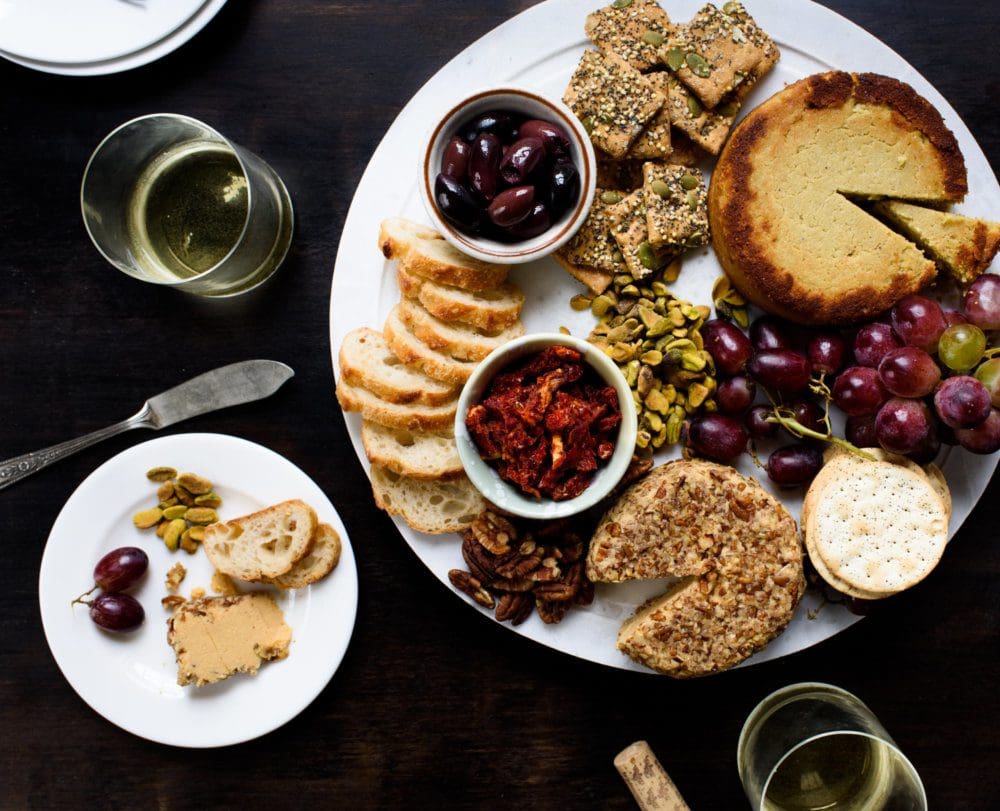
Yes, There is Life After Cheese!
By Chef Linda
I know you. You’re reading this because you’re torn. You’re confused. You feel hopeless. Either your conscience or your doctor is telling you that you need to say “goodbye” to cheese but the sweet sorrow of parting ways seems too much to bear. Maybe you’ve heard from others that they’ve given up cheese, but you can’t imagine what life would taste like without it: What about my macaroni? My lasagna? What would adorn the (veggie!) burgers on the grill? Wait…what would I have with my wine? My GOODNESS…what about the pizza? I know you because I’ve been there and I’ve got a message to share that’s millions of voices strong: Yes, there is life after cheese (and let me tell you, there’s cheesecake in it!).
But how can cheese be wrong when it feels so right?
Love at First Bite
Let’s look first at why it’s so hard to end our relationship with cheese. Believe it or not, it’s not just the taste of cheese that makes it so hard to give it up: Dairy is designed to make us fall head over heels in love with it. Dairy contains a protein called casein. When digested, fragments of this protein attach to the same brain receptors as heroin and other narcotics so each bite actually gives our brain a small dose of dopamine: Mother Nature was wise and knew calves might need some incentive to suckle until they were strong enough to survive. What makes our star-crossed relationship with dairy even worse is that cheese is the most concentrated form of casein, and as a result, contains an abundance of those pesky, addictive casomorphins. Is it any wonder we can’t imagine life without cheese? It doesn’t just taste good, it FEELS good.
And as if biology isn’t a mighty enough opponent, think about all the help it gets. Advertisers, chefs, lobbyists, processed, and fast food brands all seem to be on a mission to find new ways to cram more cheese into everything we eat. It’s a badge of honor to hoist a casserole of macaroni onto the table that boasts not two, not three, but four types of cheese. And it’s not enough to have a pizza with a double-thick layer of cheese; now we’re encouraged to order it with its crusts stuffed full of cheese, too. And while people seem to be turning to alternative kinds of milk, like oat, soy, and almond, and consumption of dairy milk is dropping dramatically, we’re actually eating more cheese than ever. In fact, reports show that between 1977 and 2017 (the most recent year for which the USDA has per-capita consumption data), annual cheese consumption for each American increased from 16 pounds to 37 pounds…per person. That’s an increase of 21 pounds! And according to the International Dairy Federation, cheese production is growing faster than any other dairy product.
Whew! That’s a lot of cheese–and a lot of sodium, saturated fat, and cholesterol. As cheese consumption rises, the health indicators for chronic diseases in America are looking worse: That’s no coincidence. According to the Physicians Committee for Responsible Medicine, cheese is THE largest source of saturated fat in the American diet and linked to an increased risk of heart disease, diabetes, and cancer. And because of the pleasure-inducing components in cheese, we’re apt to eat more than just a nibble. Is it any wonder that breaking up is hard to do?
Water, Poop, and Climate Change
These days, as we are thinking about how to better protect the earth and its resources, we should consider how dairy production contributes to our increasing demand for cheese and how that contributes to climate change. It’s no secret that the production of food requires the use of natural resources. Producing animal products for food results in less efficient use of these resources than growing plants for human consumption. Just a quick peek under the covers of dairy production demonstrates this.
It’s estimated that worldwide, there are 270 million “dairy cows”. Let’s imagine that you’re about to order a pound of sliced cheese from the deli. It takes roughly 10 gallons of milk to make that one pound of cheese. Maybe that’s not alarming, but consider that it could take as much as 2,000 gallons of water to make that one gallon of milk. (Estimates vary, but they do range from 800 to 2,000 gallons of water per pound of cheese.) That pound of cheese represents 20,000 gallons of water. Now consider the estimated 35 pounds of cheese each American consumes in a year: that’s 700,000 gallons of water being used per year per person…just for cheese. Ack!
And not to further spoil your appetite but can you imagine how much poop 270 million cows can make (and these are just the “dairy cows”, many of whom are responsible for cheese production)? Cow poop doesn’t get flushed down the toilet. No fake news here: We know that cows and their manure produce greenhouse gas emissions and that those emissions contribute to climate change. Poor handling of manure and fertilizers degrade local water resources. And dairy farming and feed production can lead to the loss of ecologically important areas, such as prairies, wetlands, and forests. How’s that pizza looking now?
Got Milk? Get the Facts.
But what would cows do with all that milk if we weren’t drinking it and using it for cheese, you might be wondering. And at least eating dairy isn’t as bad as eating meat…or is it? It seems obvious, but many good-hearted people don’t realize that milk production for human consumption is not a natural process. In order to produce the milk that goes into all the cheese we eat, “dairy cows” have to be kept perpetually pregnant against their will through artificial insemination. Just like with humans, only a mother cow who has given birth is able to produce milk. When her calf is born, her instinct is, of course, to feed her baby. Sadly, calves are immediately taken away from their mothers so that the milk can be “harvested” for human consumption and cheese production. And in order to produce the maximum amount of milk possible, female cows are pregnant nearly their entire–and very short–lives. Under normal conditions, a female cow could live for 20 years. As a “dairy cow”, she might make it to the ripe old age of six at which time she’ll be sold and slaughtered for lower-grade beef (so yes, eating cheese does contribute to the slaughter of cows.)
Adding insult to injury, to produce the massive quantities of milk required for cheese and other dairy products, cows are genetically manipulated to produce unnaturally high milk yields. Mastitis (a painful infection of the udder) is rampant, so cows are routinely fed antibiotics that end up in the milk…and cheese (along with the pus from the infection).
There’s one more ingredient you should be aware of when considering the ethics of eating cheese: rennet. Look at cheese labels (especially specialty cheeses) and you’ll notice something called rennet listed in the ingredients. Rennet is a set of enzymes found in the stomachs of ruminant animals, like cows, that actually help calves digest their mother’s milk. These enzymes help to coagulate the milk during the cheese-making process. In order to get rennet, it has to be extracted from the stomachs of recently slaughtered calves: another crime committed against cows in the name of cheese.
And finally, if you avoid veal for ethical reasons, you should know that the dairy industry feeds into the veal industry. Female calves become another generation of “dairy cows” while the males are sold off to be slaughtered for veal. Unless we kick our addiction to dairy, the veal industry will continue to thrive. Cheese. It’s a tangled web, isn’t it?
So Now What?
Change is hard but the good news is that living dairy-free does not mean you have to give up cheese! There is a world of vegan cheese out there for the taking. Store-bought options have come such a long way that you can barely compare today’s products with what you might have tried even just a few years ago. Just check the dairy section of your local store and you might be pleasantly surprised at the different options you have for shredded, sliced, and spreadable cheese. But what’s even better than that is the fact that you can make a wide variety of cheeses right in your very own home with little or no special equipment or ingredients.
You can also reference our blog and cookbook for recipes like Stovetop Mac & Cheese, Southern-Style Cheese Ball (a party-must!), ricotta, chevré, seasoned Greek feta, and many ideas that will empower you to finally say farewell to Fromage and never look back.
If you need help or have questions, please reach out and we’ll gladly share resources, our favorite brands and recipes, and everything we know. In the illustrious words of our fearless Animal Care Director, Kelly Mullins who looks into the big, soft, beautiful eyes of our rescued cows every day, “We can DO this, people!”
Photo credit: Alexandra Shytsman
Add Love + Stir, Ingredient Spotlight, Love Spoken Here, Vegan Lifestyle
Tagscheese alternatives, compassionate cuisine, Cooking Class, dairy alternatives, vegan cheese, vegan cooking classes






